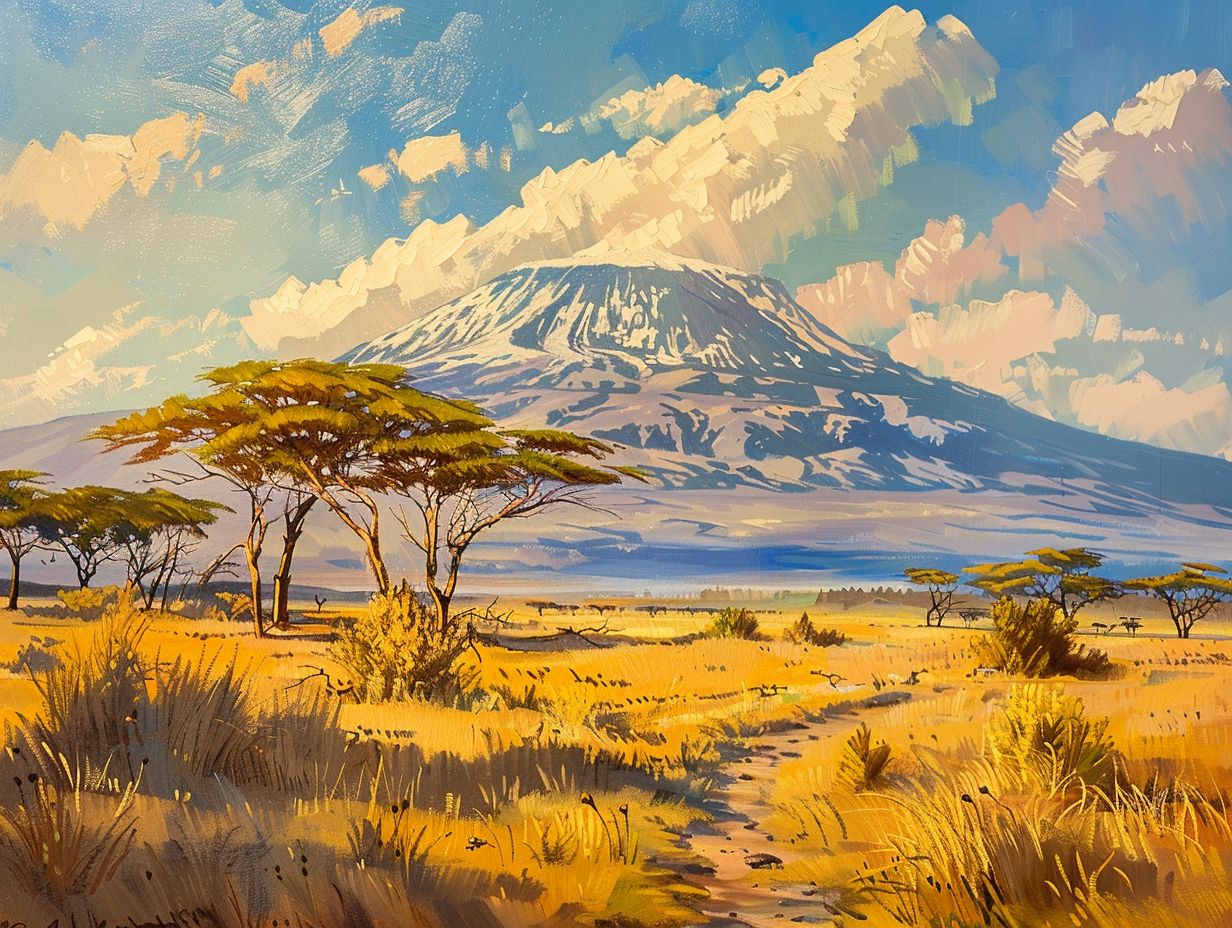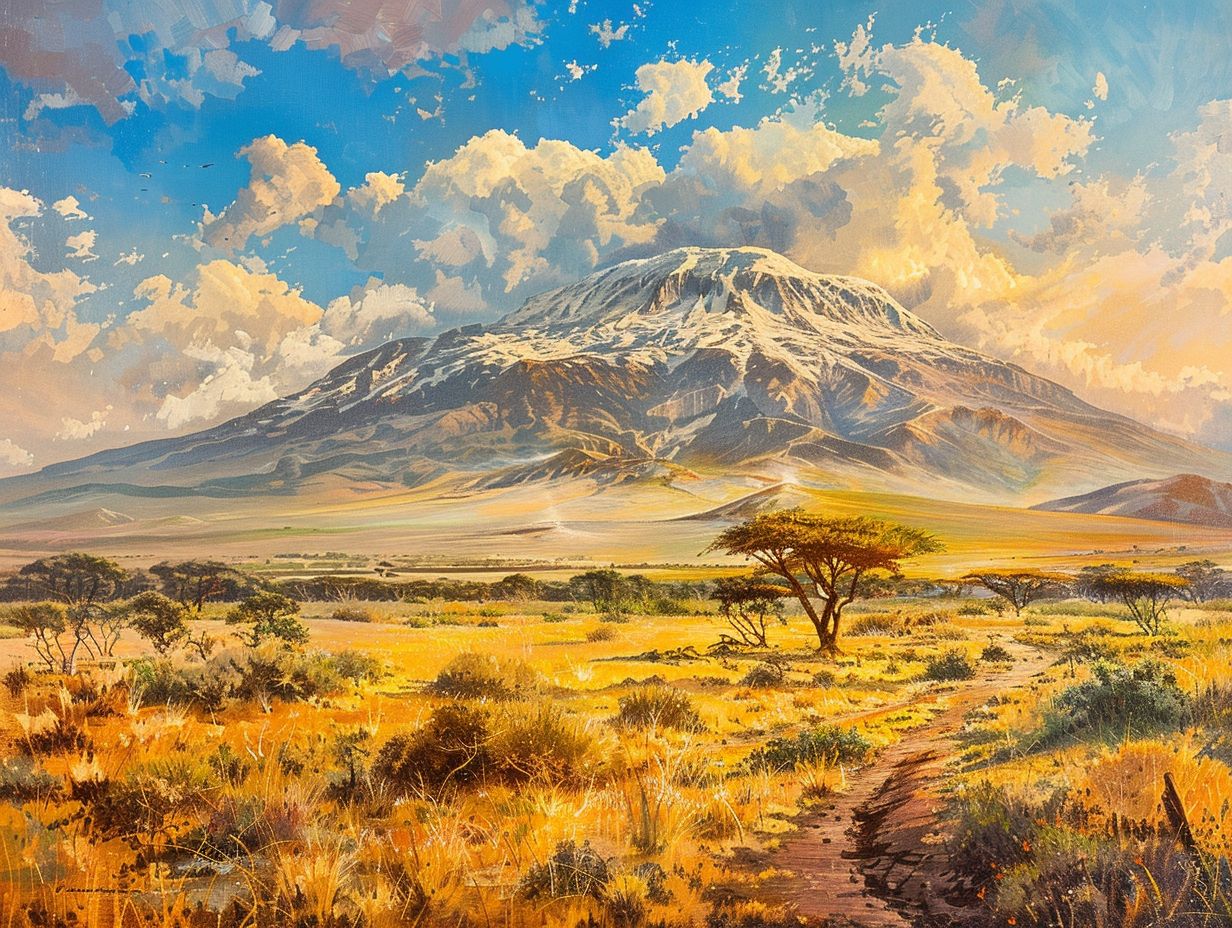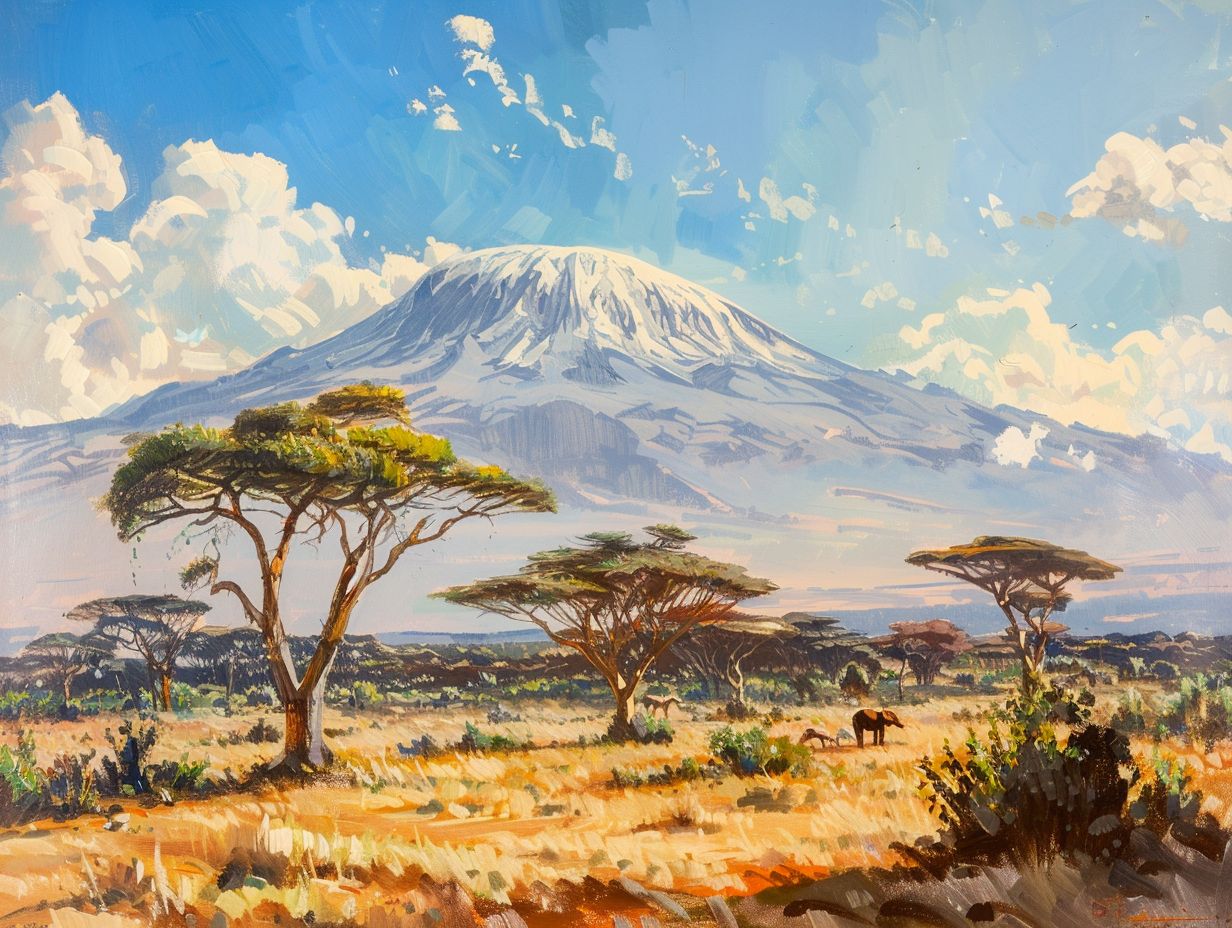
Kilimanjaro Song Jambo Bwana
Have you ever found yourself humming along to the catchy tune of “Jambo Bwana” but wondered about its meaning and significance?
This popular song, also known as the Kilimanjaro Song, has a rich history and cultural impact that extends beyond its infectious melody.
We will explore the origins of “Jambo Bwana,” its significance in the tourism industry of Tanzania, and how it has been adapted over the years.
Grab a cup of coffee and get ready to learn more about this iconic song!
Key Takeaways:

- “Jambo Bwana” is a popular Swahili song that translates to “Hello, Mister” in English.
- The song originated in Kenya and became popular in Tanzania, where it is often used as a welcoming song for tourists.
- “Jambo Bwana” has had a significant impact on Tanzanian tourism and cultural identity, and has been adapted through remixes, covers, and use in movies and TV shows.
What is the Meaning of “Jambo Bwana”?
Jambo Bwana, a popular song often associated with Kilimanjaro climb, is a joyful tune that resonates with tourists and locals alike in East Africa. Originally performed by Them Mushrooms, the song became a commercial success, attaining platinum status and captivating audiences with its lively beats and catchy lyrics.
Its origins date back to the late 1980s when Them Mushrooms, a Kenyan band, released the song as a greeting to climbers attempting the arduous trek up Mount Kilimanjaro. The lyrics, filled with words of welcome and encouragement, quickly caught on and became a staple in the region’s music scene.
As the popularity of Kilimanjaro climbed among adventurers and tourists, so did the song’s fame. Jambo Bwana served as a symbol of the determination and spirit necessary to conquer the mighty peak, creating a sense of unity and celebration among those who undertook the challenge.
History of “Jambo Bwana”:
The history of Jambo Bwana traces back to its inception by Teddy Harrison and his band in Mombasa, Kenya. Over time, the song transcended borders, gaining popularity in Tanzania and beyond, achieving commercial success and ultimately reaching platinum status.
As the catchy Swahili lyrics and upbeat tempo of Jambo Bwana resonated with audiences, it became an anthem of unity and joy, synonymous with East African melodies. The infectious rhythm and lively chorus appealed to listeners worldwide, leading to multiple covers and adaptations by diverse artists across different genres.
This timeless piece not only showcased the cultural richness of the region but also became an emblem of cross-cultural harmony, encapsulating the spirit of togetherness that music brings. Its evolution from a local sensation to an international sensation solidified its position as a musical classic, leaving an indelible mark on the global music scene.”
Origins of the Song:
The origins of the song Jambo Bwana can be traced back to its Kenyan roots, where it was inspired by the vibrant music and cultural experiences associated with the Kilimanjaro climb.
As the climbers embarked on their journey up the majestic Kilimanjaro, they were enveloped in the rich tapestry of traditional Kenyan music that echoed through the valleys and slopes. The rhythmic beats and melodious tunes served as a constant companion, infusing the expedition with a sense of unity and joy.
The song ‘Jambo Bwana’ encapsulates this communal spirit, drawing from the essence of Swahili greetings and the warm hospitality that permeates Kenyan culture. Its lively rhythm and catchy lyrics pay homage to the camaraderie and resilience displayed during the challenging climb.
Popularization of the Song:
The popularization of the song “Jambo Bwana” extended beyond Kenya to Tanzania and other parts of East Africa, where its original composition and engaging lyrics sparked conversations and became synonymous with joyful phrases and dancing.
This infectious tune quickly captured the hearts of many in the region, with its catchy chorus and vibrant rhythms spreading like wildfire. Local communities embraced the song, incorporating it into various celebrations, from weddings to cultural events.
The upbeat nature of “Jambo Bwana” not only brought people together through music but also served as a unifying force, transcending borders and language barriers.
What Language is “Jambo Bwana” in?
Jambo Bwana is a Swahili song that captivates not only locals but also foreigners, often serving as a guide to the vibrant culture and spirit of the region, resonating with listeners and porters alike.
The use of Swahili in the song ‘Jambo Bwana’ holds significant appeal to foreigners due to its exotic and melodious sound that effortlessly transports them to the beautiful landscapes and rich traditions of East Africa. This language, with its rhythmic tones and lyrical beauty, acts as a cultural bridge, allowing non-Swahili speakers to connect with the essence of the region.
For those diving into the depths of the Swahili language for the first time through this song, it offers a glimpse into the diverse and enchanting linguistic tapestry of the Swahili-speaking world. The lyrical content not only showcases the linguistic prowess of Swahili but also portrays the warmth, hospitality, and communal values deeply embedded within the culture.
Swahili Language:

The Swahili language, prominent in the song “Jambo Bwana,” enriches the lyrical content with its melodious tones and expressive phrases, fostering engaging conversations and cultural exchange.
The allure of Swahili lies in its rich history and cultural significance, serving as a language of unity and connection across diverse communities.
In “Jambo Bwana,” this linguistic beauty is showcased through vibrant greetings and heartfelt expressions that resonate with listeners worldwide.
Swahili’s rhythmic flow and poetic nuances create a captivating rhythm in the song, infusing it with a sense of warmth and authenticity.
Other Languages:
While primarily in Swahili, the song Jambo Bwana transcends language barriers, attracting foreigners and Kenyan locals alike, sparking conversations that bridge cultural divides.
Its catchy melody and upbeat rhythm create a universal appeal that resonates with listeners worldwide, regardless of their native tongue.
The song’s joyful lyrics and jubilant tone evoke a sense of unity and celebration, making it a popular choice for gatherings and events that bring people from different backgrounds together.
Through the shared experience of enjoying Jambo Bwana, individuals often find common ground and initiate discussions about the rich cultural heritage of Kenya and the significance of music in fostering community connections.
What is the Significance of “Jambo Bwana”?
“Jambo Bwana” holds significant importance in the context of Kilimanjaro climb, serving as a beacon of joy and celebration for tourists and locals alike, while also leaving a lasting cultural impact on the region.
Its melodious tunes echoing through the mountain slopes, Jambo Bwana has become intertwined with the very essence of the Kilimanjaro experience. The song’s catchy chorus and lively rhythm have a way of lifting spirits and energizing climbers during their arduous journey.
The lyrics, which embody a warm welcome in Swahili, forge a strong connection between the climbers and the local Tanzanian culture. The sense of camaraderie fostered through singing and dancing to “Jambo Bwana” creates a shared experience that transcends language barriers.
-
Tourism in Tanzania:
Within the tourism landscape of Tanzania, the song Jambo Bwana resonates with tourists embarking on the Kilimanjaro climb, adding a touch of musical exuberance to their adventurous journey.
Known for its lively beats and catchy Swahili lyrics, Jambo Bwana has become an anthem for trekkers as they ascend the majestic Mount Kilimanjaro. The song’s infectious rhythm often echoes through the foothills, uplifting spirits and fostering a sense of camaraderie among climbers from around the world.
This cultural phenomenon not only deepens the connection between visitors and the local community but also contributes to the vibrant tapestry of Tanzanian traditions that enchant travelers seeking authentic experiences.
-
Cultural Impact:
The cultural impact of “Jambo Bwana” extends beyond music, inspiring moments of joy, dancing, and communal clapping that embody the spirit of celebration and togetherness.
Forming part of the rich tapestry of East African music, “Jambo Bwana” has become a cultural icon that transcends borders and generations. Its infectious melodies and upbeat rhythms have the power to lift spirits and bring people together in a collective expression of happiness.
The song’s popularity not only resonates within the realms of music but also speaks to the resilient nature of human connection. In times of festivity or even in everyday moments, “Jambo Bwana” serves as a unifying force that bridges individuals across diverse backgrounds and experiences.
What Are the Lyrics of “Jambo Bwana”?
The lyrics of Jambo Bwana are a melodic blend of Swahili phrases and uplifting verses that invite listeners to join in the rhythmic celebration of joy and camaraderie.
Each line of the song tells a story, weaving together themes of friendship, travel, and the beauty of Africa. The term ‘Jambo Bwana’ itself, directly translating to ‘Hello, Mister’, sets the tone of a warm welcome and hospitality. The repetitive nature of the chorus, with its catchy melody, reinforces a sense of unity and togetherness amongst all who sing along.
The lyrics also pay homage to various African landscapes and wildlife, painting a vivid picture of the continent’s rich tapestry of culture and nature. Through these verses, listeners are transported on a journey that evokes a sense of wanderlust and appreciation for the vastness and diversity of Africa.
How to Pronounce “Jambo Bwana”?

Pronouncing Jambo Bwana involves capturing the rhythmic flow and tonal nuances of the Swahili language, a task that both foreigners and Kenyan enthusiasts can embrace with enthusiasm and joy.
When attempting to say Jambo Bwana, remember that ‘Jambo’ carries a clear emphasis on the first syllable, with the ‘a’ sounding like the ‘u’ in ‘cut.’
On the other hand, ‘Bwana’ has a stress on the last syllable, with ‘Bwa’ pronounced as ‘bwah’ with a sharp sound akin to ‘quah’ in ‘quartz.’ Understanding these phonetic subtleties adds depth to the greeting’s traditional meaning – ‘Hello, Mister,’ making it a cultural entry point and a warm welcome for those visiting or immersing themselves in Swahili-speaking communities.
What Are the Instruments Used in “Jambo Bwana”?
Jambo Bwana showcases a vibrant array of traditional Kenyan instruments that infuse the music with rhythmic beats and lively melodies, creating a tapestry of sound that invites listeners to dance and celebrate.
One of the iconic instruments featured in this song is the nyatiti, a plucked lyre that adds a distinctive African flavor with its mesmerizing melodies. The rhythmic backbone is provided by instruments like the ngoma drums and shakers, which drive the tempo and energy of the music, urging people to move to the infectious beats.
The use of traditional wind instruments like the orutu adds a haunting and evocative quality to the melody, enhancing the cultural richness of the composition.
How Has “Jambo Bwana” Been Adapted?
Jambo Bwana has undergone various adaptations, from remixes and covers that reinterpret its musical essence to appearances in movies and TV shows, where its infectious energy continues to captivate audiences worldwide.
Since its original release, Jambo Bwana has been reimagined in numerous musical styles, reflecting its versatility and enduring appeal. Artists across genres have put their unique spin on the song, infusing it with their artistic flair while paying homage to the original charm. The track has found its way into visual media, enhancing the ambiance of scenes in movies and TV programs.
Its catchy melody and uplifting lyrics serve as a universal language that transcends borders and connects people through the power of music.
-
Remixes and Covers:
The remixes and covers of Jambo Bwana offer fresh interpretations of the song, blending diverse musical styles and rhythms to create reimagined versions that inspire new waves of dance and celebration.
Over the years, these reinterpretations have played a significant role in transforming the original tune into a global phenomenon, reaching audiences far beyond its initial release. Artists from different corners of the world have put their unique spin on the track, infusing it with elements of electronic beats, traditional instruments, and contemporary production techniques.
This fusion of cultures and sounds not only revitalizes the spirit of the song but also showcases the power of music in transcending boundaries and fostering a sense of unity among listeners. The evolution of Jambo Bwana through these remixes and covers emphasizes the ever-changing landscape of music, where creativity knows no bounds.
-
Use in Movies and TV Shows:
The presence of Jambo Bwana in movies and TV shows adds a touch of joy and vibrancy to visual media, elevating moments of celebration and cultural resonance through its infectious and uplifting melodies.
When this iconic song is woven into a scene, it often serves as more than just background music, becoming a central element that mirrors the mood and theme of the storyline.
The catchy rhythm and optimistic lyrics of Jambo Bwana create an atmosphere of communal revelry and unity among characters, fostering a sense of togetherness and mutual enjoyment. It has the remarkable ability to transport viewers to faraway lands, cultivating a sense of wanderlust and curiosity about different cultures and traditions.
What Are the Similar Songs to “Jambo Bwana”?
Songs like Malaika and Hakuna Matata share the infectious energy and uplifting spirit reminiscent of Jambo Bwana, creating a musical tapestry that celebrates joy, dance, and cultural unity.
These songs resonate with audiences through their melodic rhythms and vibrant instrumentation that evoke a sense of communal celebration. The themes of love, happiness, and resilience permeate through the lyrics, echoing the optimistic and spirited essence found in ‘Jambo Bwana’.
The rhythmic beats and lively choruses in songs like ‘Waka Waka’ by Shakira or ‘Tsaiky Tsaiky’ by Tao Ravao also capture the essence of celebration and togetherness, much like the vibrant tones of ‘Jambo Bwana’.
-
Malaika:

Malaika,” a Kenyan song steeped in Chakacha and Benga rhythms, embodies a soulful melody that resonates with audiences, capturing the essence of love, longing, and cultural heritage.
Originating from the Swahili language, Malaika means ‘angel,’ symbolizing purity and beauty.
The fusion of Chakacha, a coastal dance rhythm, with the lively Benga music, creates a unique and dynamic musical experience.
Lyrically, the song navigates themes of unrequited love and yearning, striking a chord with listeners across generations. Its poignant storytelling and emotive vocals evoke a sense of nostalgia and heartfelt emotion.
-
Hakuna Matata:
Hakuna Matata,” a reggae classic popularized by groups like Mombasa Roots and Safari Sound Band, embodies a carefree spirit that celebrates life and resilience, resonating with audiences across diverse cultural landscapes.
The uplifting melodies and catchy lyrics of the song have made it a timeless anthem for individuals seeking solace in its message of positivity and peace.
The influence of bands like Mombasa Roots and Safari Sound Band can be felt in the rhythmic beats and soothing harmonies that define the reggae genre. Through its infectious rhythm, “Hakuna Matata” captures the essence of carefree living, offering a musical escape that transcends borders and languages.
Frequently Asked Questions:
1. What is the meaning behind the Kilimanjaro Song Jambo Bwana?
A: The Kilimanjaro Song Jambo Bwana is a popular Swahili song that translates to “Hello Mister” in English. It is a warm and welcoming song often used as a greeting to visitors.
2. Who composed the Kilimanjaro Song Jambo Bwana?
A: The Kilimanjaro Song Jambo Bwana was composed by Kenyan musician Teddy Kalanda Harrison in 1982. He was inspired by his experiences climbing Mount Kilimanjaro and wanted to create a song that captured the spirit of the mountain.
3. Is the Kilimanjaro Song Jambo Bwana a traditional African song?
A: No, the Kilimanjaro Song Jambo Bwana is not a traditional African song. It was written and composed in the 1980s and has become a popular song throughout East Africa and beyond.
4. What is the significance of Mount Kilimanjaro in the Kilimanjaro Song Jambo Bwana?
A: Mount Kilimanjaro is the highest mountain in Africa and is often referred to as the “Roof of Africa.” The song celebrates the beauty and majesty of the mountain and its importance in the region.
5. Can I learn the dance moves to the Kilimanjaro Song Jambo Bwana?
A: Yes, there are many tutorials available online that teach the dance moves to the Kilimanjaro Song Jambo Bwana. It is a fun and energetic dance that is often performed at celebrations and events.
6. Is the Kilimanjaro Song Jambo Bwana only sung in Swahili?
A: While the original version of the Kilimanjaro Song Jambo Bwana is in Swahili, there have been many covers and translations in different languages. It is a universal song that can be enjoyed and sung by people of all nationalities.